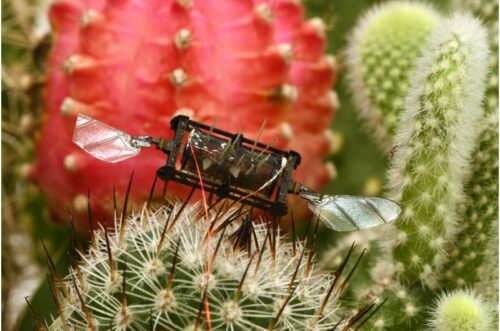Researchers from MIT have developed a bumblebee inspired soft robot that keeps flying even after cutting 20% of its wing tip.
It is estimated that a foraging bee bumps into a flower about once per second, which damages its wings over time. Yet despite having many tiny rips or holes in their wings, bumblebees can still fly. On the other hand, poke holes in the robot’s wing motors or chop off part of its propeller, and it goes down.

MIT researchers have developed repair techniques that enable a bug-sized aerial robot to sustain severe damage to the actuators, or artificial muscles, that power its wings—but to still fly effectively. They optimized these artificial muscles so the robot can better isolate defects and overcome minor damage, like tiny holes in the actuator. In addition, they demonstrated a novel laser repair method that can help the robot recover from severe damage, such as a fire that scorches the device.
Using their techniques, a damaged robot could maintain flight-level performance after one of its artificial muscles was jabbed by 10 needles, and the actuator was still able to operate after a large hole was burnt into it. Their repair methods enabled a robot to keep flying even after the researchers cut off 20% of its wing tip.
Wings on each corner are powered by dielectric elastomer actuators (DEAs), which are soft artificial muscles that use mechanical forces to rapidly flap the wings. These artificial muscles are made from layers of elastomer that are sandwiched between two razor-thin electrodes and then rolled into a squishy tube. When voltage is applied to the DEA, the electrodes squeeze the elastomer, which flaps the wing. About 15 years ago, researchers found they could prevent DEA failures from one tiny defect using a physical phenomenon known as self-clearing. In this process, applying high voltage to the DEA disconnects the local electrode around a small defect, isolating that failure from the rest of the electrode so the artificial muscle still works.

Once they had perfected their techniques, the researchers conducted tests with damaged actuators—some had been jabbed by many needles while other had holes burned into them. They measured how well the robot performed in flapping wing, take-off, and hovering experiments. Even with damaged DEAs, the repair techniques enabled the robot to maintain its flight performance, with altitude, position, and attitude errors that deviated only very slightly from those of an undamaged robot. With laser surgery, a DEA that would have been broken beyond repair was able to recover 87 percent of its performance.
Reference : Suhan Kim et al, Laser-assisted failure recovery for dielectric elastomer actuators in aerial robots, Science Robotics (2023). DOI: 10.1126/scirobotics.adf4278. www.science.org/doi/10.1126/scirobotics.adf4278







